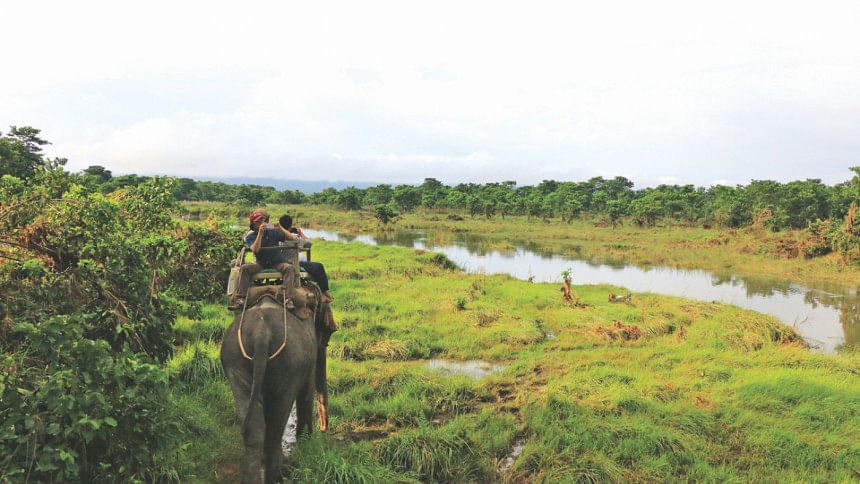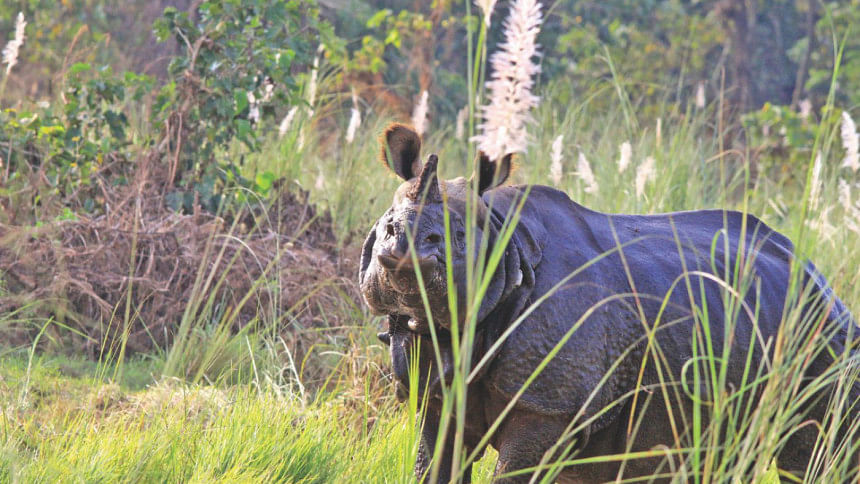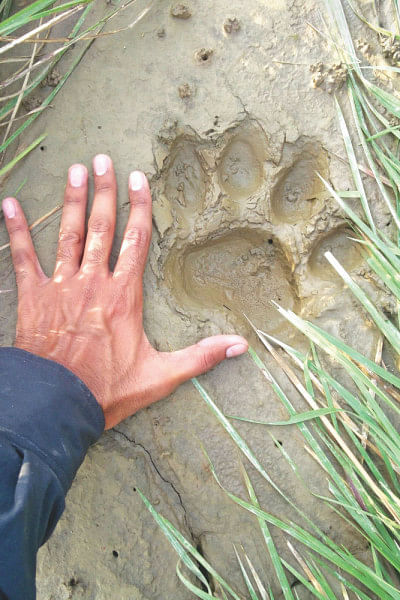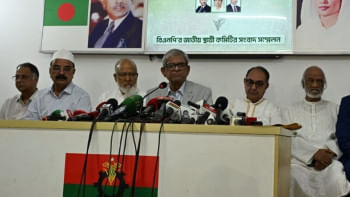Thoughts from Chitwan - Where the wild ones roam free

A massive rhino rustled through the tall elephant grass and charged at us. Ears cocked, nostrils flared wide open and tail held high, the animal seemed to take up the entirety of the unique Chitwan landscape. Its distinctive one horn cut through the thick humid air of the Terai, its muscles rippled in tension under the thick armour like skin.
We quickly made a hasty retreat, fearful of the encounter, realising how little we were in that vastness. We moved a safe distance away and the cameras were quickly brought out. The *click click* sound of the cameras broke the quiet of the landscape. In awe, everyone kept staring at the enormous beast, now captured forever on the camera roll.
It was then that we noticed a radio collar attached to its thick, leathery neck. We learned from our guides that we had become audience to a part of Nepal's wonderful conservation programme. A programme that aimed to bring back the greater one-horned rhino, the gentle giants of the grasslands, back from the brink of extinction.
The greater one-horned rhino's scientific name is the Rhinoceros Unicornis, inspired from the mythical one horned animal, the unicorn. And even a few odd years ago, spotting a one-horned rhino was as rare (read impossible) as spotting an actual unicorn. It goes to show the enormous effort and dedication of nations like Nepal and India in bringing these animals back from disappearing forever.
As 'development' cuts away at the last of our wild places, incredible ecosystems like the Chitwan National Park have been put aside to give wildlife one last chance at survival.
As my flight touched down in Kathmandu, I was greeted by the madness and mayhem that is the capital city. Dust hung low, horns beeped everywhere and I could not for a moment grasp that some sixty miles away from here, in the lowlands, roamed majestic creatures, that far from here, is a patch of land that still held a little bit of the grand old forest. The forest that once possibly spanned across the landscape and boasted of incredible thrills. I was in Nepal during the height of monsoon and after a back-breaking eleven hour ride through muddy terrains, broken roads and mountain passes, I was finally in jungle country.
The Rhino charge ended as suddenly as it had begun and we found ourselves in another part of the park, surrounded by elephant grass and wild sugarcanes, taller than most of us. We were engulfed by the forest. The moment, a distant reminder of what life must have been like before we managed to tame everything. Walking through the maze of grass, we emerged into an opening and a bit of high ground. It felt good to be out of the swampy, incredibly humid and disorienting grassy labyrinth. But the surprises of Chitwan were far from over.
As soon we were out, an incredible, heady stench consumed us. When our wits finally caught up to us, we realised we had stumbled upon a tiger kill.

The kill, probably a Chital, was reduced to a few scraps of bloodied bones. Fresh tiger pugmarks, walked away from the site of the gory kill. The pugmarks were enormous; bigger than my spread-out hand. The place the tiger had laid to rest was still warm and the green supple blades of grass were still bent and had not regained their upright posture. Our guide whispered not to panic. He said, "Tigers are the most revered animals in this forest." The other guide pressed his palms together in a pranam, and mouthed a prayer to the departed soul of the deer and for the rightful owner that claimed it.
Wild encounters greet you in every corner of this incredible ecosystem of sal forests, riverine forests and savanna grasslands. Home to hundreds of species of birds, their ubiquitous calls and colours, will remain with me forever.
We quietly found our way back to our rustic wooden canoe, still mystified and processing the string of events that had unfolded. We floated quietly down the Rapti river, filled to the brim from the recent floods and downpour, through the national park.
Once a famous hunting ground for the Nepalese upper class, Chitwan is the country's first national park. Established in 1973, the park is incredibly bio-diverse, teeming with life and wonderfully managed by the Nepalese government. It is also a UNESCO World Heritage Site, very much like our own magical mangrove forest, Sundarbans. This national park sits in the Terai region, the outer foothills of the Himalayas, throwing it in the heart of a subtropical climate. Initially, hunting and poaching took a heavy toll on the animals, so much so, that rhino populations dwindled to only 95. But since then, thanks to some wonderful management practices, and anti-poaching techniques, the rhino population is now over 600 individuals, and one of the highest densities anywhere on Earth. And Chitwan is one of the few places that is home to Asia's Big Five. Asia's five big megafauna: Bengal tiger, greater one-horned rhino, Asian elephant, sloth bear and mugger crocodiles.

With thoughts of wild encounters on my mind, we floated down effortlessly through the murky river, mesmerised by the beauty and serenity on offer. A Sambar deer came down to the river to drink, eyeing our boat cautiously, only to be scared away by a wild boar crashing through the undergrowth. On the soft, river-bank, basked a gharial, lazy and majestic at the same time.
A plethora of birds had started their afternoon orchestra all singing out of tune yet somehow the songs mingled into the forest in perfect harmony.
Evening was approaching quickly in the Terai land and soon everything seemed to merge into one living breathing being. It wasn't long before we were all lost in our moments. That is what such vast landscapes do to you. Submerged in our thoughts, each of us took a moment to enjoy this wonderland in our own way.
Aren't these the moments that we look for constantly, moments we look to find inspiration, to trudge through the mundane? To run away from it all, and exist only in the present? In the "now"?
Places so pristine gives us a chance to reflect and recalibrate and help us find the inspiration for life. I could not help but feel when I involuntarily compared what we had lost, and what some had embraced as treasure. These rhinos once roamed the lush alluvial floodplains of our Bengal, and Bengal tigers stalked the land. Now the rhinos are gone and the tigers are trapped in the shrinking Sundarbans, threated to be possibly wiped out forever by Rampal Power Plant and other industries cropping up on the periphery of the forest.
We are forgetting the intrinsic value of places still untouched, unaffected by greed, where we can still feel the calm and gentle rhythm of life that inspire us to feel empathy towards a wild and untamed landscape. Sometimes as simple as just floating down a river and watching a deer quench its thirst.
Sakib Ahmed is an aspiring conservationist working in Bangladesh and enjoys a life in the wilderness.





Comments